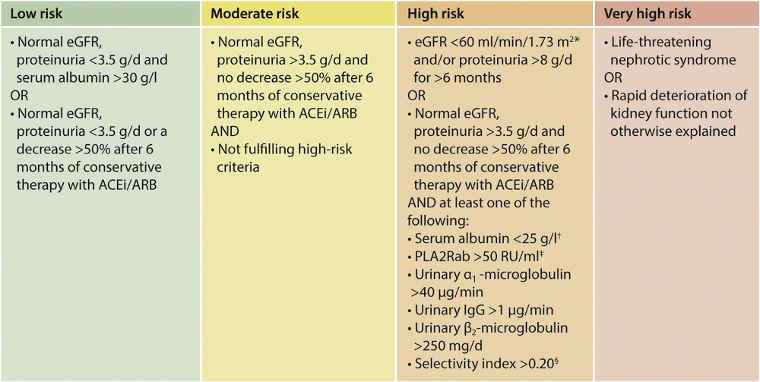Approach
The treatment approach in all patients with MN is based on risk of progression to kidney failure.[20] Supportive care with sodium restriction and diuretics to control edema, a low protein diet (allowing for replacement of urinary protein losses), BP control by ACE inhibitors or angiotensin receptor blocker therapy to minimize proteinuria, and statins for hyperlipidemia should be initiated in all patients at the time of diagnosis.[1] Treatment of secondary membranous nephropathy (MN) also involves treatment of the underlying cause.[23]
Risk of progressive kidney injury
Patients are divided into four categories based on the risk of progressive loss of kidney function:[20]
Low risk: normal estimated glomerular filtration rate (eGFR), proteinuria <3.5 g/day, and serum albumin >30 g/L; OR normal eGFR, proteinuria <3.5 g/day, or a decrease >50% after 6 months of conservative therapy with ACE inhibitors/angiotensin-II receptor antagonists.
Moderate risk: normal eGFR, proteinuria >3.5 g/day, and no decrease >50% after 6 months of conservative therapy with ACE inhibitors/angiotensin-II receptor antagonists; AND not fulfilling high-risk criteria.
High risk: eGFR <60 mL/min/1.73 m2, and/or proteinuria >8 g/day for >6 months; OR normal eGFR, proteinuria >3.5 g/day, and no decrease >50% after 6 months of conservative therapy with ACE inhibitors/angiotensin-II receptor antagonists; AND at least one of the following: serum albumin <25 g/L, PLA2Rab >50 RU/mL, urinary alpha-1-microglobulin >40 micrograms/min, urinary IgG >1 micrograms/min, urinary beta-2-microglobulin >250 mg/day, and/or selectivity index >0.20.
Very high risk: life-threatening nephrotic syndrome; OR rapid deterioration of kidney function not otherwise explained.
[Figure caption and citation for the preceding image starts]: Clinical criteria for assessing risk of progressive loss of kidney functionKidney Int. 2021 Oct;100(4S):S1-S276; used with permission [Citation ends]. [Figure caption and citation for the preceding image starts]: Risk-based treatment of membranous nephropathy (*see table Clinical criteria for assessing risk of progressive loss of kidney function)Kidney Int. 2021 Oct;100(4S):S1-S276; used with permission [Citation ends].
[Figure caption and citation for the preceding image starts]: Risk-based treatment of membranous nephropathy (*see table Clinical criteria for assessing risk of progressive loss of kidney function)Kidney Int. 2021 Oct;100(4S):S1-S276; used with permission [Citation ends].
Dietary advice
Dietary sodium restriction and diuretics should be used to manage edema.[1] Reducing protein intake to approximately 0.8 g/kg daily based on ideal body weight decreases nephrotic-range proteinuria. However, dietary protein restriction alone is unlikely to induce complete remission of MN.[24]
Antihypertensive drugs
ACE inhibitors can reduce proteinuria and slow progression of renal disease and are the preferred medications to treat hypertension.[1][4] Angiotensin-II receptor antagonists may be prescribed if ACE inhibitors are not tolerated. In the Modification of Diet in Renal Disease study, patients with proteinuria > 1 g/day had a significantly better outcome when their blood pressure was reduced to a lower target of 125/75 mmHg, compared with those with a higher blood pressure target.[25] The antiproteinuric effect is generally modest (<30% decrease) and is more significant in patients with lower levels of proteinuria. In patients showing a significant antiproteinuric response, the effect is usually seen within 2 months of initiation of treatment. Patients should be instructed to follow a low-salt diet, because a high intake can significantly impair the beneficial effects of angiotensin II blockade.
Diuretics
Diuretics are initiated to treat edema. Furosemide is the first choice and may be used in combination with a thiazide diuretic if edema cannot be successfully managed with monotherapy.[4] It is advisable to check electrolyte levels before treatment is started and to monitor these at follow-up appointments.
Statins
Hyperlipidemia is common in patients with MN. Lipid abnormalities are important factors in the high vascular risk associated with proteinuria; thus, treatment of hyperlipidemia is very important.[4]
Corticosteroid, cytotoxic, and immunosuppressive therapy
The Kidney Disease: Improving Global Outcomes (KDIGO) clinical practice guideline for glomerulonephritis suggests that the initial therapy for primary MN should consist of optimal supportive care; immunosuppressive therapy should be restricted to patients considered at moderate, high, or very high risk for progressive kidney injury.[20] Patients should be managed conservatively for at least 6 months on a course of alternating monthly cycles of glucocorticoids and an alkylating agent or rituximab before the treatment is considered to have failed.[20] Depending on the risk estimate, calcineurin inhibitor-based therapy (cyclosporine or tacrolimus) for ≥6 months can also be offered.
A combination of corticosteroids and chlorambucil, cyclophosphamide, or cyclosporine can be offered to patients at medium, high, and very high risk of progression to kidney failure. The long-term side effects of cytotoxic agents include reduced fertility, bladder carcinoma, and myelodysplasia, which are the major drawbacks to the universal application of this form of treatment.
One Cochrane review found that a corticosteroid plus an alkylating agent had short- and long-term benefits on adult primary MN with nephrotic syndrome, and that cyclophosphamide was safer than chlorambucil.[26]
One meta-analysis showed that rituximab can significantly reduce the level of proteinuria compared to the controls.[27] In addition, the treatment group showed a greater reduction in the risk of kidney failure ESRD than the control group.[27] However, further investigation and validation in large and high quality randomized controlled trials is recommended.[26]
The choice between a cyclophosphamide/chlorambucil-based and a cyclosporine-based regimen depends principally on clinician and patient preference. The preferred initial therapy consists of a 6-month course of alternating monthly cycles of oral and intravenous corticosteroids, and oral alkylating agents. Oral cyclophosphamide is the preferred alkylating agent.[20] Cyclosporine or tacrolimus should be used for patients who meet the criteria for initial therapy, but who choose not to receive the cyclical corticosteroids/alkylating agent regimen, or who have contraindication to this regimen.[20]
Duration of treatment in patients with high risk of progression should be tailored to the individual patients and their response to treatment. Relapses are treated in the same way as initial episodes according to the risk of progression to end-stage renal disease. Prophylaxis for Pneumocystis pneumonia in patients receiving cyclophosphamide and prophylaxis for thrush in patients taking corticosteroids is recommended.
Use of this content is subject to our disclaimer